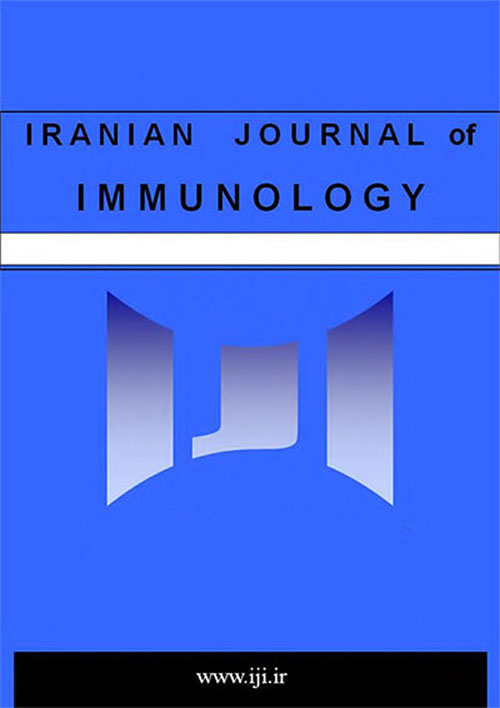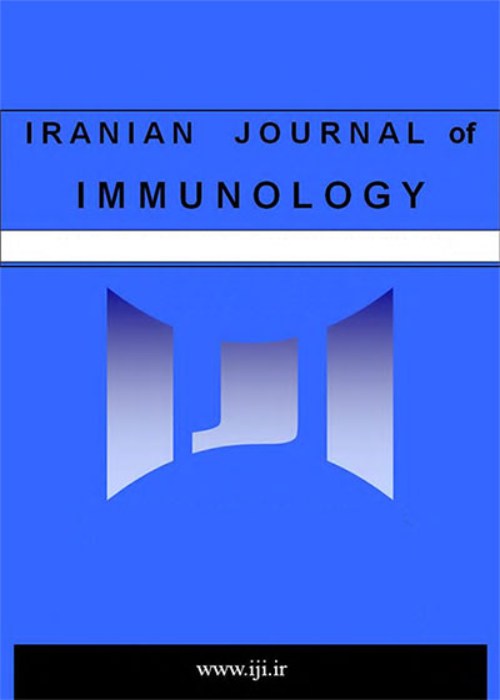فهرست مطالب

Iranian journal of immunology
Volume:16 Issue: 4, Autumn 2019
- تاریخ انتشار: 1398/10/09
- تعداد عناوین: 8
-
-
Pages 268-277BackgroundDendritic cells (DCs) contribute essentially to the outset and course of immune responses. So in patients with malignancy, there have been considerable interests in use of these cells in different interventions.ObjectiveTo evaluate the impact of Leishmania major’s components on DC maturation and their use as a therapeutic agent against tumor cells.MethodsThe cancer model was induced by injection of WEHI-164 cells (BALB/c derived fibrosarcoma cell line) subcutaneously in the right flank of animals. Bone-marrow derived DCs (BMDCs) were cultured with granulocyte-macrophage colony-stimulating factor (GM-CSF) and IL-4. After 5 days, tumor lysate, Leishmania major’s lysate, and Lipopolysaccharide (LPS) were added to the culture and incubated for 2 days. IL-12 production in DCs was measured by ELISA. For Immunotherapy, Mice received DCs subcutaneously around the tumor site. Two weeks after DCs injection, cytotoxicity assay and infiltration of CD8+ lymphocytes were evaluated.ResultsOur results showed that immunotherapy with dendritic cells exposed to Leishmania extract led to producing a higher amount of IL-12, compare to the control group. A considerable increment in specific cytotoxic T cells activity, diminished tumor growth rate and improved survival of immunized animals were seen.ConclusionThis study indicates that the use of Leishmania major extract, as well as LPS, can enhance the efficiency of DC-based vaccines and provides a basis for the use of Leishmania major in DC-targeted clinical therapies.Keywords: cancer, Dendritic cell, immunotherapy, Leishmania Major
-
Pages 278-290BackgroundMultiple myeloma (MM) is a malignant plasma cell proliferative disorder with limited immunotherapy treatment because of T cell dysfunction.ObjectiveTo investigate the immunomodulatory function of bone marrow mesenchymal stromal cells (MM-BMSCs) on CD8+ T cells.MethodsProliferation and cytotoxicity were detected by cell counting kit-8 assay. Cell cycle was detected by flow cytometry, and p16 expression was detected by PCR. The expression of fibroblast activation protein α (FAPα) was evaluated by immunohistochemistry.ResultsCo-culture of CD8+ T cells with MM-BMSCs decreased the cell survival rate and increased the killing rate (p=0.03, p=0.001, respectively), the percentage of cells in G0/G1 phase and p16 expression (p<0.001). FAPα was mainly in the mesenchymal matrix of the MM microenvironment and elevated in MM derived bone marrow compared to healthy donors (p<0.001). The FAPα inhibitor PT-100, increased survival and the killing rate (p<0.001, p=0.043, respectively), and decreased the percentage of cells in G0/G1 phase and p16 expression (p=0.024, p=0.004, respectively).ConclusionTherefore, MM-BMSCs inhibit the proliferation and cytotoxicity of CD8+ T cells, significantly block the cell cycle and increase p16 expression in co-cultured CD8+ T cells in a cell-cell contact-dependent manner.Keywords: Bone Marrow Mesenchymal Stromal Cells_CD8+ T Cell Anergy_Fibroblast Activation Protein a_Multiple myeloma
-
Pages 291-298BackgroundNK (natural killer) and NKT (natural killer T) cells, as components of innate immune system, play a crucial role in tumor progression and dissemination.ObjectiveTo investigate the percentages of NK cells, NKT cells, iNKT (invariant natural killer T) cells, total T lymphocytes as well as activated T lymphocytes, in tumor draining lymph nodes (TDLNs) of patients with breast cancer (BC) and their association with different clinic-pathological features of the patients.MethodsAxillary lymph nodes were obtained from 30 Iranian women with breast cancer. After routine pathological evaluations, mononuclear cells were separated from their lymph nodes and incubated with appropriate fluorochrome conjugated monoclonal antibodies specific for CD3, HLA-DR, CD16/56, and Vα24Jα18-TCR. Data were collected on a four-color flow cytometer and analyzed by CellQuest software.ResultsThe mean percentages of NK (CD3-CD16/56+), NKT (CD3+CD16/56+) and iNKT (Vα24Jα18-TCR+) cells in TDLNs mononuclear cells of BC patients were 2.04%, 2.44% and 0.1%, respectively. A significant decrease in the percentages of NK and iNKT subsets in patients with grade I was observed compared to grade III (p=0.03 and p=0.01, respectively). Moreover, NK cells were increased in patients with grade III of BC compared to grade II (p= 0.003).ConclusionThe increase in the percentage of NK and iNKT cells in TDLNs of patients with higher grade of BC might suggest a suppressive phenotype for these cells in breast cancer, which merit more functional investigation.Keywords: Breast cancer, Lymph nodes, Invariant-NKT Cells, NK Cells, NKT Cells
-
Pages 299-310Background
Behçet's disease (BD) is a systemic inflammatory disease with a chronic, relapsing-remitting course of unknown etiology. Neuro-Behcet’s disease (NBD) induce serious CNS complications and are known to be the main cause of long-term morbidity and mortality. IL‐37 is a natural suppressor of innate inflammation which its role in NBD has not been fully understood.
ObjectiveTo determine the expression of IL-37 in cerebrospinal fluid (CSF) and its relationship with other inflammatory cytokines.
MethodsLevel of IL-37, IL-6, IL-17, IL-21, TSLP and TGF-β were measured in CSF of 22 patients with NBD and 12 non-inflammatory neurological disease (NIND) and 10 headache attributed to Behçet's disease (HaBD) by enzyme‐linked immunosorbent assay (ELISA). In addition, IL-37 mRNA relative expression was detected by quantitative reverse transcriptase‐polymerase chain reaction (RT‐PCR).
ResultsCSF level and mRNA expression of IL‐37 were elevated in NBD patients compared to those in NIND and HaBD patients. Levels of IL-6, IL-17, IL-21 and TSLP were found to be increased in NBD patients and were inversely associated with IL-37 level. Moreover, TGF-β level in CSF of NBD patients was positively correlated with IL-37 levels. IL-37 increased significantly after treatment and in remission group, but TGF-β was only increased in treatment group.
ConclusionIL‐37 expression increased in NBD patients, and correlated with disease activity. Our data conclude that IL-37 could be a disease marker in NBD, however it requires further studies.
Keywords: Interlukine-37, Inflammatory cytokines, Neuro-Behçet’s Disease -
Pages 311-320Background
Visceral leishmaniasis (VL) can lead to death in more than 95% of cases if left untreated. Accurate and early diagnosis has an important role in reducing mortality rate of this disease.
ObjectiveTo express recombinant H2B antigen from an Iranian isolate of Leishmania Infantum and evaluate its efficacy in the diagnosis of VL.
MethodsThe recombinant H2B antigen was produced in a prokaryotic system, and its efficacy for VL diagnosis was evaluated by ELISA. The serum samples from 80 VL patients, 100 individuals from endemic and non-endemic regions of VL, and 58 non-VL patients were collected. VL cases were confirmed based on the clinical sign, positive IFAT (>64), real time PCR, and response to treatment.
ResultsThe H2B gene sequence of the Iranian L. infantum isolate had about 4% diversity in comparison with the H2B gene of the L. infantum counterpart. ELISA, using the produced H2B recombinant antigen, showed sensitivity of 71.25% (95% CI: 60.05%-80.82%) and specificity of 69.62% (95% CI: 61.81%-76.68%) regarding VL diagnosis.
ConclusionRecombinant H2B antigen expressed in the prokaryotic system had suboptimal performance for the serological diagnosis of VL. It seems that the production and expression of recombinant H2B antigen in a eukaryotic system may enhance the performance of this antigen in the diagnosis of VL in Iran.
Keywords: Iran, Human, Recombinant H2B Antigen, Serological Diagnosis, visceral leishmaniasis -
Pages 321-326Background
Fungal aeroallergens might sensitize the airway which in turn produces a specific cytokine profile.
ObjectiveTo evaluate the IL-25 and IL-33 profile in patients with fungal allergic rhinitis.
MethodsThe present study examined patients who were evaluated due to allergic rhinitis (AR) at Emam Reza Hospital of Shiraz, Iran. The allergic patients were categorized based on the skin prick test. Blood samples were collected and allergen-specific IgE and cytokine profiles were analyzed.
Results184 patients were enrolled in the study and in 35 of whom fungal rhinitis was confirmed. The levels of specific IgE in patients with fungal allergy were statistically significant compared to those in the control group (p<0.000). However, there were no significant differences in IL-25 and IL-33 levels between fungal and none-fungal AR patients.
ConclusionChronic fungal challenge might regulate innate system cytokines in severe persistent AR.
Keywords: Allergic Fungal Sinusitis, Interleukin-25, Interleukin-33, IgE -
Pages 327-333Background
Pro-inflammatory cytokines are associated with systemic inflammatory responses.
ObjectiveTo investigate the levels of pro-inflammatory cytokines (IL-1b, IL-6, and TNF-a) in patients with non-alcoholic fatty liver (NAFL) and non-alcoholic steatohepatitis (NASH) compared to healthy individuals.
MethodsThis case-control study was conducted on 30 patients with NAFL, 30 patients with NASH, and 30 healthy volunteers. The plasma level of IL-1b, IL-6, and TNF-a were determined by ELISA, and biochemical parameters were measured using colorimetric methods.
ResultsIL-1b and IL-6 levels were significantly higher in patients with NASH compared with NAFL and control group. However, TNF-a levels had no significant variations in NAFL and NASH patients compared to the control group (p=0.903 and p=0.960, respectively).
ConclusionResults showed that the levels of ALT activity and pro-inflammatory cytokines were higher in patients with NASH compared to control and NAFL subjects; Therefore, steatosis and inflammation develop as a result of excessive pro-inflammatory factors in NASH.
Keywords: Interleukin-1β, Interleukin-6, Non-Alcoholic Fatty Liver, Non-Alcoholic Steatohepatitis, Tumor Necrosis Factor-α -
Pages 334-338
Severe Combined Immunodeficiency (SCID), characterized by a profound decrease in both the number and function of T cells, is related to more than 20 different mutations. Recombination-activating gene (RAG) 1 and 2 seem to be two of the most common forms presenting with various manifestations, including typical SCID, Omenn syndrome (OS), atypical SCID (AS), or delayed onset combined immunodeficiency with granulomas. One interesting manifestation in RAG mutation is the change in the immunophenotype over time, even after hematopoietic stem cell transplantation (HSCT). As bone marrow transplantation (BMT) is the only curative treatment of SCID, it is necessary to differentiate between SCID and OS due to the different conditioning regimens (CR). We present a novel case of atypical SCID (SCID manifestations with more than 300 CD3+T cells) caused by RAG 2 gene mutation whose immunophenotype changed to atypical Omenn syndrome (all Omenn syndrome manifestations except rash, eosinophilia, and elevated IgE) over time.Differentiation of leaky SCID, SCID and Omenn syndrome in RAG mutation genes and overlap manifestations is important in treatment plan and prognosis.
Keywords: Atypical Omen Syndrome_Atypical SCID_RAG 2 Mutation_Severe Combined Immunodeficiency


